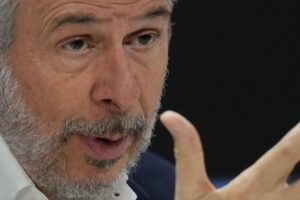
With millions of native animals killed on Australian roads each year, researchers warn governments are not doing enough to monitor and implement road-safety measures that could protect vulnerable fauna. A range of interventions exist — including tunnels, rope and land bridges, exclusion fencing and other structures that help wildlife move safely around roads.But new research from Griffith University has identified “systemic” gaps in how these measures are applied across the country.Fauna-sensitive road design standards are largely optional, the researchers warn, and without a national framework with clear rules, their deployment will likely remain “patchy and insufficiently supported by policy”.
Road crashes involving wildlife take an enormous toll on native animals, as well as the people involved — including drivers, rescuers, and veterinary staff.
Wildlife Victoria has reported a 288 per cent increase in calls about wildlife collisions with vehicles over the past 10 years. The organisation says it has helped 311 species hit by vehicles, with kangaroos representing 50 to 60 per cent of cases. The Royal Automobile Club of Victoria (RACV) said it received nearly 7,000 claims last year involving animal impacts.Some estimates place Australia’s annual wildlife toll as high as 10 million.
“That’s an insanely massive number,” the study’s lead author, road ecologist Christopher Johnson, told AAP.
Wildlife protections treated as ‘nice-to-haves’
Queensland and Victoria are the only states with wildlife-sensitive guidelines embedded in their road designs, although those standards are voluntary.In an analysis of Queensland’s Fauna Sensitive Road Design manual, the study identified 99 statements that used the terminology “should”, while only 64 used “must”.
Victoria’s guidelines similarly favoured voluntary language over enforceable rules.
Kangaroos and larger animals are the most visible victims of vehicle accidents, but many smaller animals are also killed, and typically go unreported. Source: Getty / John Moore
The study called for biodiversity to be at the core of infrastructure planning, rather than being left open to interpretation.”If we treated building a wildlife bridge with the same approach as we would a pedestrian bridge, we’d have a lot better outcomes,” Johnson said.
“Nice-to-haves don’t always make it through to the end of the project.”
What are some of the ways to protect wildlife around roads?
Kylie Soanes is a research fellow in urban biodiversity at the University of Melbourne who has done extensive research on road ecology and wildlife crossings.
She told SBS News it’s all about understanding the impacts of a specific stretch of road on the local ecosystems.
“We think more ecologically about what’s in the entire area and what’s likely to come into contact with the road and what its response is going to be when it gets there, rather than just reacting to where maybe someone hit a kangaroo with their car,” she said.Fencing, when designed properly, can be “really effective” in preventing wildlife deaths on roads, she said.However, it can block important pathways for animals, making it difficult for them to reach certain areas where they can breed or feed.
That’s when wildlife crossing structures can be useful tools to help animals move across safely.
“Maybe there’s a pond on one side of the road and a forest on the other. So animals are frequently crossing to access,” she said.Animals that are attracted to roads and that lack the skills to evade cars are particularly susceptible to accidents, she said. “Snakes and lizards that might come out warm themselves up on nice hot bitumen and then not be able to move away in time,” she said.
“Turtles, things that move along the ground relatively slowly, they tend to be at a really big risk.”
Reality of death tolls ‘probably worse’ than estimates
There is no national database that tracks the extent of wildlife road deaths.”We are terrible at recording this information,” Soanes said, noting that Australia faces challenges compared to some other countries, which do have databases, due to its size.
Estimates are often extrapolated from figures reported by insurance companies or wildlife rescue groups.
That means they’re likely “an underestimate, when you think beyond kangaroos and koalas and wombats, but also include turtles and lizards and frogs … and all the things that we hit and we don’t see and we don’t record,” Soanes said.”It’s probably worse, unfortunately.”— With additional reporting by the Australian Associated Press.
Source





